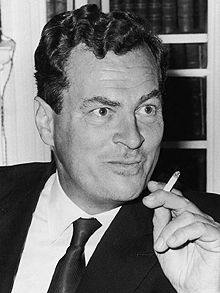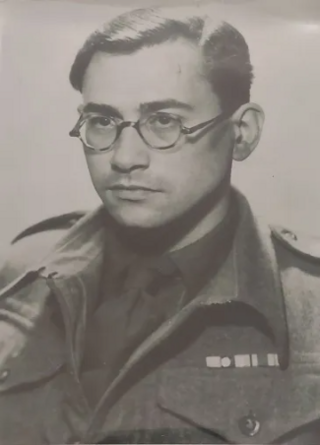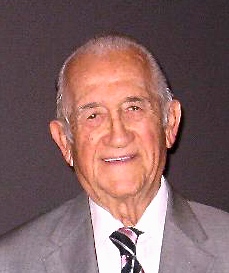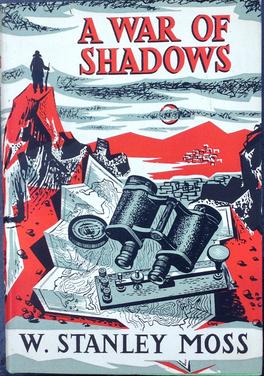
Sir Patrick Michael Leigh Fermor was an English writer, scholar, soldier and polyglot. He played a prominent role in the Cretan resistance during the Second World War, and was widely seen as Britain's greatest living travel writer, on the basis of books such as A Time of Gifts (1977). A BBC journalist once termed him "a cross between Indiana Jones, James Bond and Graham Greene".

Alexander Percival Feilman Wallace, known as Xan Fielding, was a British author, translator, journalist and traveller, who served as a Special Operations Executive (SOE) agent in Crete, France and East Asia during World War II. The purpose of SOE was to conduct espionage, sabotage and reconnaissance in occupied Europe and Asia against the Axis powers, especially Nazi Germany.

Ill Met by Moonlight (1957), released in the USA as Night Ambush, is a film by the British writer-director-producer team of Michael Powell and Emeric Pressburger, and the last movie they made together through their production company "The Archers". The film, which stars Dirk Bogarde and features Marius Goring, David Oxley, and Cyril Cusack, is based on the 1950 book Ill Met by Moonlight: The Abduction of General Kreipe by W. Stanley Moss, which is an account of events during the author's service on Crete during World War II as an agent of the Special Operations Executive (SOE). The title is a quotation from Shakespeare's A Midsummer Night's Dream, and the book features the young agents' capture and evacuation of the German general Heinrich Kreipe.

The 22nd Infantry Division, which soon became the 22nd Air Landing Division, was a specialized German infantry division in World War II. Its primary method of transportation was gliders. The division played a significant role in the development of modern day air assault operations. Towards the end of the war, the formation was reshaped into the 22nd Volksgrenadier Division.

Ivan William Stanley Moss MC, commonly known as W. Stanley Moss or Billy Moss, was a British army officer in World War II, and later a successful writer, broadcaster, journalist, and traveller. He served with the Coldstream Guards and the Special Operations Executive (SOE) and is best known for the Kidnap of General Kreipe. He was a best-selling author in the 1950s, based on his novels and books about his wartime service. His SOE years are featured in Ill Met by Moonlight: The Abduction of General Kreipe, and A War of Shadows. Moss travelled around the world, including Antarctica to meet the Commonwealth Trans-Antarctic Expedition.

The Cretan resistance was a resistance movement against the occupying forces of Nazi Germany and Fascist Italy by the residents of the Greek island of Crete during World War II. Part of the larger Greek resistance, it lasted from 20 May 1941, when the German Wehrmacht invaded the island in the Battle of Crete, until the spring of 1945 when they surrendered to the British. For the first time during World War II, attacking German forces faced in Crete a substantial resistance from the local population. In the Battle of Crete, Cretan civilians picked off paratroopers or attacked them with knives, axes, scythes, or even bare hands. As a result, many casualties were inflicted upon the invading German paratroopers during the battle.

The 11th Day: Crete 1941 is a 2005 documentary film featuring eyewitness accounts from survivors of the Battle of Crete during World War II. The film was created by producer-director Christos Epperson and writer-producer Michael Epperson, and funded by Alex Spanos. Among the eyewitnesses interviewed are British SOE operative and famous travel writer Patrick Leigh Fermor, along with George Doundoulakis, and Cretan Resistance hero George Tzitzikas. The film also includes historical commentary and analysis by Chase Brandon of the CIA and Professor Andre Gerolymatos of Simon Fraser University.

Karl Heinrich Georg Ferdinand Kreipe was a German career soldier who served in both World War I and World War II. While leading German forces in occupied Crete in April 1944, he was abducted by British SOE officers Patrick Leigh Fermor and William Stanley Moss, with the support of the Cretan resistance.

Friedrich-Wilhelm Müller was a general in the Wehrmacht of Nazi Germany during World War II. He led an infantry regiment in the early stages of the war and by 1943 was commander of the 22nd Air Landing Division. Under his orders, troops of the division committed atrocities against Greek civilians. He was later commander of occupied Crete and his harsh methods of controlling the island saw him nicknamed "The Butcher of Crete." After the war he was convicted and executed by a Greek court for war crimes.

Angelico (Angelo) Carta was an Italian military officer, best known for his actions during the Axis occupation of Crete in World War II.

The Damasta sabotage was an attack by Cretan resistance fighters led by British Special Operations Executive officer Captain Bill Stanley Moss MC against German occupation forces in World War II. The attack occurred on 8 August 1944 near the village of Damasta and was aimed at preventing the Germans assaulting the village of Anogeia.

Helias Doundoulakis was a Greek American civil engineer who patented the suspension system for the at-the-time largest radio telescope in the world. During WWII he served in the United States Army and the Office of Strategic Services (OSS) as a spy.

The kidnapping of Heinrich Kreipe was an operation executed jointly by the British Special Operations Executive (SOE) and local resistance members in Crete in German-occupied Greece during the Second World War. Operation 'BRICKLAYER' was launched on 4 February 1944, when SOE officer Patrick Leigh Fermor landed in Crete with the intention of abducting notorious war criminal and commander of 22nd Air Landing Division, Friedrich-Wilhelm Müller. By the time of the arrival of the rest of the abduction team, led by William Stanley Moss, two months later, Müller had been succeeded by Heinrich Kreipe, who was chosen as the new target.

Sophie Moss was a Polish noblewoman and World War II organiser. At the request of Władysław Sikorski, Poland's wartime leader, she founded the Cairo branch of the Polish Red Cross.

The Viannos massacres were a mass extermination campaign launched by German forces against the civilian residents of around 20 villages located in the areas of east Viannos and west Ierapetra provinces on the Greek island of Crete during World War II. The killings, with a death toll in excess of 500, were carried out on 14–16 September 1943 by Wehrmacht units. They were accompanied by the burning of most villages, looting, and the destruction of harvests.
Dennis John Ciclitira was a British soldier and businessman of Greek descent.

A War of Shadows is a non-fiction book written by W. Stanley Moss, a British soldier, writer and traveller, best known, together with Patrick Leigh Fermor, for the Kidnap of General Kreipe as described in Moss’s book Ill Met by Moonlight. Moss recounts his subsequent activities during World War II as agent of the Special Operations Executive (SOE) in Crete, Macedonia (Greece) and Siam (Thailand). The 2014 editions contain an Introduction by one of Moss's children and a short biography, Billy Moss: Soldier, Writer, Traveller - A Brief Life by Alan Ogden as an Afterword.

The Razing of Anogeia or the Holocaust of Anogeia refers to the complete destruction of the village of Anogeia in central Crete (Greece) and the murder of about 25 of its inhabitants on 13 August 1944 by German occupying forces during World War II. This was the third time Anogeia was destroyed, as the Ottomans had destroyed it twice; first in July 1822 and again in November 1867, during the Great Cretan Revolt.
Kimonas or Kimon Zografakis, frequently referred to by his nom de guerre, Black Man, was a distinguished Greek partisan in the Cretan resistance from 1941 to 1944 against the Axis occupation forces.
George James Doundoulakis was a Greek American physicist and soldier who worked under British Intelligence during World War II with SOE agent Patrick Leigh Fermor, and then served with the OSS in Thessaly, Greece.
















